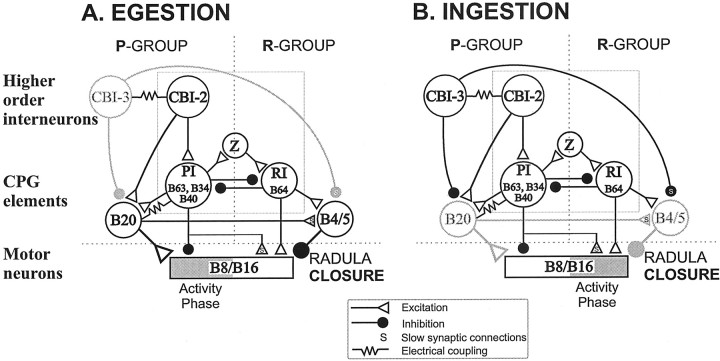Fig. 17.
Functional configurations of theAplysia feeding CPG in the egestive (A) and ingestive (B) modes. Each cycle of buccal motor programs consists of two phases: radula protraction (P) and retraction (R), which are mediated respectively by protraction phase interneurons (PI) [i.e., B34, B63 (Hurwitz et al., 1997), and B40] and retraction phase interneurons (RI) [e.g., B64 (Hurwitz and Susswein, 1996)]. B40 is a newly identified buccal–cerebral interneuron (Jing and Weiss, 2001). The protraction phase is initiated by CBI-2, which drives PIs. Mutual inhibition between PIs and RIs ensures that protraction and retraction phases alternate with respect to each other. The switch from protraction to retraction is presumed to be mediated by a hypothesizedz cell, which receives excitation from PIs and in turn activates the RIs (Baxter et al., 1997). The main criterion for distinguishing between ingestive and egestive motor programs is the timing of activity in radula closure motoneurons B8 and B16 (Cropper et al., 1990; Morton and Chiel, 1993a,b; Church and Lloyd, 1994). During ingestion, radula closure occurs primarily during retraction (B). During egestion, radula closure occurs during protraction (A). A, In the absence of CBI-3 activity, CBI-2 drives B20 through direct and indirect (via PIs) pathways. B20 in turn enhances B4/5 firing. Strong activity in B20 induces B8/B16 firing during protraction; thus the motor programs are egestive. In the protraction phase, the weak inhibitory connections from PIs to B8 are overridden by excitatory actions of B20 (compare Fig. 11C). In the retraction phase, the excitatory connections from RIs and PIs to B8/B16 are overridden by B4/5 (compare Fig. 4A, 2, B, 2).B, When CBI-3 is coactive with CBI-2, ingestive programs are generated. Fast and slow inhibitory actions of CBI-3 functionally remove B20 and B4/5 from the circuit. In the absence of excitation from B20 during protraction, fast inhibition of B8 by the PIs suppresses B8 firing. During the retraction phase, the inhibitory input from B4/5 is no longer present; therefore, a combination of slow and fast excitation, originating respectively from the PIs (B34 and B40) and the RIs, induces B8 firing. Thus, B8 and B16 fire during retraction, and the motor programs become ingestive. Note that the inhibitory connection from B64 to B20 is omitted for clarity. Inactive neurons and their synaptic outputs are shown in gray.

